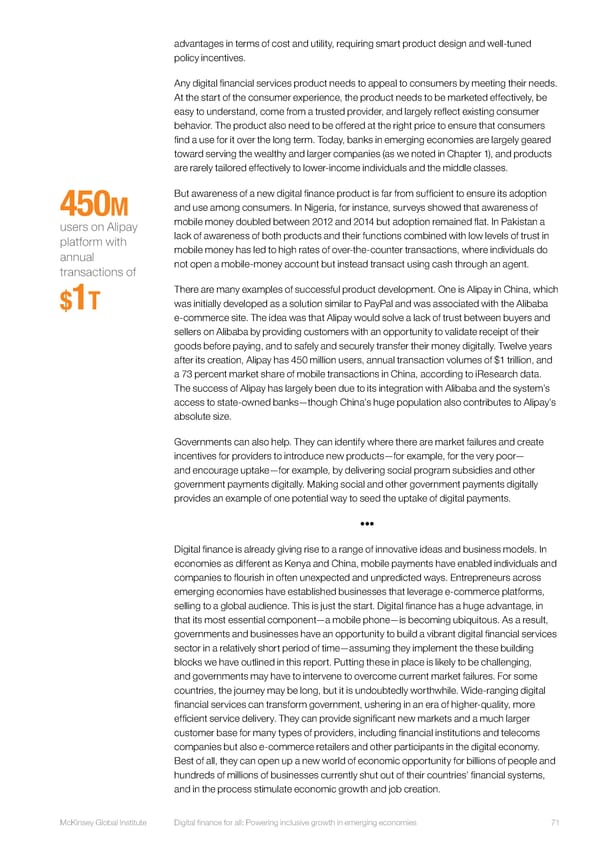advantages in terms of cost and utility, requiring smart product design and well-tuned policy incentives. Any digital financial services product needs to appeal to consumers by meeting their needs. At the start of the consumer experience, the product needs to be marketed effectively, be easy to understand, come from a trusted provider, and largely reflect existing consumer behavior. The product also need to be offered at the right price to ensure that consumers find a use for it over the long term. Today, banks in emerging economies are largely geared toward serving the wealthy and larger companies (as we noted in Chapter 1), and products are rarely tailored effectively to lower-income individuals and the middle classes. But awareness of a new digital finance product is far from sufficient to ensure its adoption 450M and use among consumers. In Nigeria, for instance, surveys showed that awareness of users on Alipay mobile money doubled between 2012 and 2014 but adoption remained flat. In Pakistan a platform with lack of awareness of both products and their functions combined with low levels of trust in annual mobile money has led to high rates of over-the-counter transactions, where individuals do transactions of not open a mobile-money account but instead transact using cash through an agent. There are many examples of successful product development. One is Alipay in China, which $1T was initially developed as a solution similar to PayPal and was associated with the Alibaba e-commerce site. The idea was that Alipay would solve a lack of trust between buyers and sellers on Alibaba by providing customers with an opportunity to validate receipt of their goods before paying, and to safely and securely transfer their money digitally. Twelve years after its creation, Alipay has 450 million users, annual transaction volumes of $1 trillion, and a 73 percent market share of mobile transactions in China, according to iResearch data. The success of Alipay has largely been due to its integration with Alibaba and the system’s access to state-owned banks—though China’s huge population also contributes to Alipay’s absolute size. Governments can also help. They can identify where there are market failures and create incentives for providers to introduce new products—for example, for the very poor— and encourage uptake—for example, by delivering social program subsidies and other government payments digitally. Making social and other government payments digitally provides an example of one potential way to seed the uptake of digital payments. ••• Digital finance is already giving rise to a range of innovative ideas and business models. In economies as different as Kenya and China, mobile payments have enabled individuals and companies to flourish in often unexpected and unpredicted ways. Entrepreneurs across emerging economies have established businesses that leverage e-commerce platforms, selling to a global audience. This is just the start. Digital finance has a huge advantage, in that its most essential component—a mobile phone—is becoming ubiquitous. As a result, governments and businesses have an opportunity to build a vibrant digital financial services sector in a relatively short period of time—assuming they implement the these building blocks we have outlined in this report. Putting these in place is likely to be challenging, and governments may have to intervene to overcome current market failures. For some countries, the journey may be long, but it is undoubtedly worthwhile. Wide-ranging digital financial services can transform government, ushering in an era of higher-quality, more efficient service delivery. They can provide significant new markets and a much larger customer base for many types of providers, including financial institutions and telecoms companies but also e-commerce retailers and other participants in the digital economy. Best of all, they can open up a new world of economic opportunity for billions of people and hundreds of millions of businesses currently shut out of their countries’ financial systems, and in the process stimulate economic growth and job creation. McKinsey Global Institute Digital finance for all: Powering inclusive growth in emerging economies 71
 DIGITAL FINANCE FOR ALL Page 85 Page 87
DIGITAL FINANCE FOR ALL Page 85 Page 87